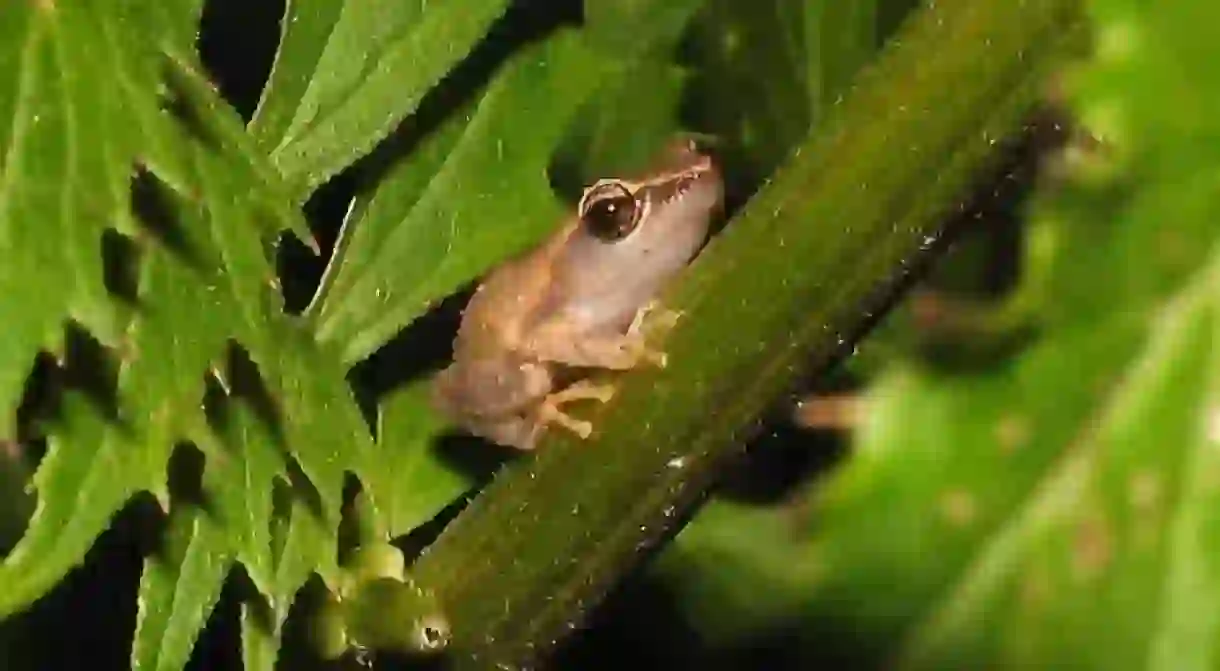Native Amphibians and Reptiles of Puerto Rico

There are few wild mammals on the island of Puerto Rico, and the only native one is the bat, but that does not mean the fauna is uninteresting. There are 17 varieties of coquí alone, and the rest of the native amphibian and reptile world of Puerto Rico is abundant.
Puerto Rican Boa
Also known as the yellow tree boa, this non-venomous snake is brown in color and can grow 6-8 feet (2-3 meters) long. This boa is a viviparous snake, which means it gives birth to live young. It feeds on small mammals, birds and lizards, and since it lives in the karst region of Puerto Rico on the Northwest coast where there are caves, it also feeds on bats.

Coquí
The male coquí’s mating call of “ko-kee,” from which it gets its common name, has been measured at 90 to 100 decibels, making it the loudest existing amphibian. Once found only in Puerto Rico, the coquí is the cultural symbol of the island. There are 17 different coquís on the island that range in color from green to yellow to brown with various accent colors. The Welcome to Puerto Rico website informs us that coquís reproduce year-round, the male is the one who guards the eggs and protects the young for about 5 days after they hatch. Unlike most other frogs, coquís do not have a free-living tadpole stage, the young emerge as fully formed coquís.

Puerto Rican Crested Toad
Originally described in 1868, the crested toad is found only in Puerto Rico and the Virgin Islands. Habitat loss has resulted in a decline in population and it being placed on the list of threatened species by the US Fish and Wildlife Service in 1987. Before that in 1984 a Species Survival Program was initiated. According to the website of the Puerto Rican Crested Toad Recovery Program, there have been over 300,000 captive-hatched crested toad tadpoles released in Puerto Rico.

Puerto Rican Worm Lizard
Also known as the Common Blind Snake, the worm lizard can be found in El Yunque. According to the rainforest’s page on the USDA website, the worm lizard “is pinkish-brown on the head and tail with many dark spots on the annuli (body rings) of which there are between 214 and 237 in this species. It measures 10 inches (260 millimeters) in length, from snout to vent. Because it is somewhat difficult to distinguish it’s head from it’s tail it is sometimes referred to as a “two-headed snake” (in Puerto Rico “Culebra de dos cabezas”) by local people. According to folklore, wearing a live [worm lizard] on your body ‘helps safeguard pregnancy’ while wearing a dead snake ‘helps rherumatism’.” Worm lizards can be found under logs and rocks.

Anole
Anoles are the cute little lizards you see all over Puerto Rico. It is a prolific genus with over 391 worldwide, and there are 9 varieties on the island. Anoles hatch at about 3/4-1 inch (25 mm), and grow to about 5-6 inches (127-152.4 mm) SVL (snout to vent length), with the females being an inch or so smaller than the males. The anole can also change color from brown to a bright green and back again, but so far no one knows why.

Puerto Rican Galliwasp
“The Puerto Rican Galliwasp is a snake-like, elongated, flattened lizard with tiny limbs, a thick, heavy tail and almost no indentations separating the head, trunk and tail. Its primary color is a dark, shiny mahogany brown, with dusky wavy lines across the back that can only be seen under close observation. There is a dark brown line that extends from the rear of the head to the tail – a series of dark spots above the line are occasionally observed, giving the line a “scalloped” look. A series of white lines radiate from the area surrounding the eyes to the jaw. Rear flanks are yellow with dark edges. The underparts are grayish-tan and the throat and chin display darker spots,” according to the United States Department of Agriculture. Galliwasps can measure up to 5 inches (125 mms) SVL, but the ones in Puerto Rico are usually much smaller.
Puerto Rican Skink
There are four different skinks found in Puerto Rico, but only one is native. They prefer dense clumps of cacti in semi-arid regions, but can also be found around rocks and under coconut palms. Skinks eat invertebrates and plants.

Puerto Rican Upland Gecko
The Sphaerodactylus klauber is also known as Klauber’s Dwarf Gecko, named for American herpetologist Laurence Monroe Klauber. These geckos are found at higher elevations in El Yunque. They are insectivores whose SVL is about 6 inches (15.2 cm).

Puerto Rican Racer
The Racer is the second largest snake in Puerto Rico, but still only grows to about 3 feet (.9 meters) in length. The Puerto Rican Racer is the only venomous snake on the island, but it is only mildly so. If bitten you may experience swelling, soreness and mild discoloration. When cornered, the Racer will rise up on its lower body and extend the skin around its neck, looking much like a cobra. It is found in El Yunque where it dines on coquí and anole. It is a ground dweller, but can sometimes be found in trees.














